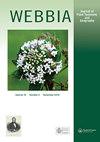Effects of climate change on the occurrence of charophytes and angiosperms in a brackish environment
Q3 Agricultural and Biological Sciences
引用次数: 5
Abstract
ABSTRACT The potential response of occurrence of charophyte and angiosperm communities to climate change in the brackish environment of the Baltic Sea was investigated using the boosted regression trees (BRT) modelling method. The aim of the study was to analyse sensitivity of various species to climate change and to predict the changes in species’ distribution under projected changes of environmental variables. The results showed that depth was the most influential environmental variable in predicting the spatial distribution of charophytes and angiosperms. Other environmental variables had notably lower importance in determining community structure and the order of importance was species specific. The exceptions were the charophytes Chara horrida and C. tomentosa, for which the influence of wave exposure was stronger than the influence of depth. The studied species could be divided into three groups based on the predicted effect of climate change: (1) species that benefit from change (Chara connivens, Potamogeton perfoliatus, Myriophyllum spicatum, C. aspera, C. baltica, C. canescens, Ruppia maritima), (2) species with no notable change (Chara tomentosa, C. horrida, Stuckenia pectinata), and (3) species that decline (Zostera marina, Zannichellia palustris, Tolypella nidifica). Currently, the shallow and sheltered West Estonian Archipelago Sea hosts favourable habitat conditions for most of the charophyte and angiosperm species. The most significant predicted change was the decline or disappearance of brackish and marine species and the increase of freshwater species due to the expected decrease of salinity in the Baltic Sea.气候变化对微咸水环境中轮藻和被子植物发生的影响
摘要采用增强回归树(BRT)建模方法研究了波罗的海半咸淡环境中蕨类和被子植物群落的发生对气候变化的潜在响应。研究的目的是分析各种物种对气候变化的敏感性,并预测在预测的环境变量变化下物种分布的变化。结果表明,深度是预测蕨类植物和被子植物空间分布的最重要环境变量。其他环境变量对群落结构的影响程度较低,其影响程度有种间差异。除了Chara horda和C. tomentosa,波浪暴露的影响大于深度的影响。根据气候变化的预测效应,将研究物种分为三类:受益于气候变化的物种(Chara connivens, Potamogeton perfoliatus, Myriophyllum spicatum, C. aspera, C. baltica, C. canescens, Ruppia marima),无显著变化的物种(Chara tomentosa, C. horda, Stuckenia pectinata),以及受益于气候变化的物种(Zostera marina, Zannichellia palustris, Tolypella nidifica)。目前,浅海和庇护的西爱沙尼亚群岛海为大多数蕨类和被子植物物种提供了有利的栖息地条件。预测变化最显著的是咸淡水和海洋物种的减少或消失,以及淡水物种的增加,这是由于波罗的海盐度的预期降低。
本文章由计算机程序翻译,如有差异,请以英文原文为准。
求助全文
约1分钟内获得全文
求助全文

 求助内容:
求助内容: 应助结果提醒方式:
应助结果提醒方式:


